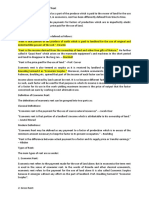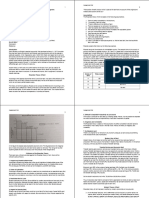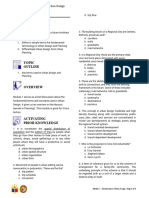0 ratings0% found this document useful (0 votes)
31 viewsLearning Objectives: Housing Module 5 - Theories in Housing
The document discusses several theories related to housing, including rent theory, classical political economy, Heinrich von Thünen's model of the isolated state, and neoclassical urban economics. It outlines concepts like land rent, differential rent, and how these theories explain the spatial development of land and income distribution.
Uploaded by
Jeric Gonzales MadronioCopyright
© © All Rights Reserved
Available Formats
Download as PDF, TXT or read online on Scribd
0 ratings0% found this document useful (0 votes)
31 viewsLearning Objectives: Housing Module 5 - Theories in Housing
The document discusses several theories related to housing, including rent theory, classical political economy, Heinrich von Thünen's model of the isolated state, and neoclassical urban economics. It outlines concepts like land rent, differential rent, and how these theories explain the spatial development of land and income distribution.
Uploaded by
Jeric Gonzales MadronioCopyright
© © All Rights Reserved
Available Formats
Download as PDF, TXT or read online on Scribd
You are on page 1/ 8
3.
Single-f amily detached
HOUSING dwelling unit containing
Module 5 – THEORIES IN HOUSING three or more separate living
units grouped closely together to f orm relatively
compact structures
a. socialized housing
LEARNING b. cluster housing
c. townhouse
OBJECTIVES
4. Is a one-story house, cottage or cabin. It is
Af ter studying this module, you as a f uture Architect generally small in terms of square f ootage, but it is not
should be able to: uncommon to see very large bungalows. It was
originally designed to provide af f ordable, modern
1. Enumerate and explain the dif f erent housing f or the working class .
Theories in Housing a. cabin
b. ancestral mansion
TOPIC c. bungalow
OUTLINE 5. A ________________ is a large property complex
divided into individual units and sold. Ownership
1. Theories in Housing usually includes a nonexclusive interest in certain
"community property" controlled by the condominium
management.
a. condominium
b. mansion
OVERVIEW c. socialized housing
Module 5 serves as a brief discussion or review on
the known Theories in allied f ields such as economics
and geography that are applicable in Housing. It gives THEORIES IN HOUSING
us an overview on the various theories on housing
and how it inf luences the housing industry. This Some Known Theories in Housing
module is good f or 3 hour lecture.
An excerpt from Encyclopedia of Urban Studies
ACTIVATING RENT THEORY
Land rent refers to the payment of a tribute to a
PRIOR KNOWLEDGE landowner. As an institution or social relation, it
. regulates the use of land. Because the total sum
1. ________________ are def ined as having one or of capitalized future rent payments constitutes
more adults in addition to the head of household and the land price, land rent has an impact on the
spouse or partner, such as an adult child living at distribution of income between different classes
home, two related or unrelated f amilies residing or groups in society. In classical political
together, or a parent living with an adult child. economy, it was a crucial concept for
a. doubled up household understanding the relative income of landlords,
b. singled out household capitalists, and workers. In current debates, land
c. preoccupied household
rent is used to explain the location of productive
2. A structure or part of a structure where a household activities as well as the spatial segregation of
lives. It has direct access f rom the outside of the different social groups within the urban and
building, either directly or through a common hall. regional context. In general, land rent is crucial
a. housing building to the explanation of spatial development and its
b. housing unit articulation with economic and social processes.
c. housing edif ice
Classical Political Economy
Module 3 –Cultural Beliefs in Housing| Page 1 of 8
The main concern of the classical economists also included in a rudimentary way in the work of
was Smith. Their concepts were based on the idea
to understand the overall dynamics of economic that rent is nothing natural but a historically
accumulation and growth and to explain the developed institution or social relation. They also
distribution of income among different social defined land as a fictitious commodity that is not
classes. Adam Smith, David Ricardo, and Karl produced within the capitalist system of
Marx lived in a social environment that was production. Rather, private property rights are
heavily dominated by the weight of agricultural assigned to nature in order to make land a
production in the economy and, hence, by the commodity.
relatively important social power of landlords.
One of the main questions was how landlords
were affected by economic growth and whether Heinrich von Thünen
their existence was a barrier to a dynamic and New Urban Economics
accumulation of capital. Smith represents, by Heinrich von Thünen, a forerunner of
and large, a rather harmonistic perspective neoclassical reasoning, developed his model of
regarding the interests of landlords and the isolated state in 1826. It was based on
capitalists. Both are supposed to benefit from differential rent, which was further developed
economic growth, capitalists in the form of into a model of marginal productivity. The model
increasing profits and landlords in the form of explains rents in terms of transport costs to a city
higher rents. Taking a different tack, Ricardo center and the specific production conditions for
focused primarily on differential rent. This goods. In fact, the rent mechanism determines
brought him to a rather pessimistic perspective the type of agricultural goods produced at
on the role of land rent and to an antagonistic different distances from the center. In von
view with regard to the relationship between Thünen’s theoretical perspective, land rent is
landlords and industrial capitalists. The concept based not on social institutions but on the
of differential rent is based on the idea that the conditions of production and transport costs.
source of rent is different qualities of land, such Neoclassical theory may be understood as the
as the type of soil and the distance to market. application of differential rent in the form of
Better-quality land should yield a higher rent. marginal thinking and, hence, the application of
The price of goods produced is determined by scarcity to all types of economic resources.
the conditions of production on the worst land, Nevertheless, in the 1960s, the Cambridge
that s, land that yields no differential rent. Controversy in Capital put neoclassical theory
Ricardo argued that a further expansion of and its understanding of capital into question. In
capitalism would lead to the inclusion of land of the debate, Pierro Sraffa from Cambridge in the
inferior quality, thereby increasing differential United Kingdom and other critics argued that
rent and reducing the profits of the capitalist, who neoclassical marginal theory was unable to
has to pay higher wages to workers to allow for explain the distribution of income and, hence, the
their reproduction. He assumed that wages are distribution of profits between rents and wages,
determined by a subsistence level, which in a without already assuming a given distribution of
simplified case consists of a certain amount of wealth. This means that profits are not
wheat. If additional land of inferior quality is used determined by marginal productivity but rather
for production, productivity falls. This lower that the social conditions of production
productivity means that the costs of production determine the rate of profit. Hence, a rent theory
of the amount of wheat necessary for a worker’s based on a neoclassical understanding of capital
subsistence increases, and therefore, capitalists is problematic.
have to pay higher wages. At the same time,
differential rent for all other landowners is Despite these theoretical problems, in 1964,
increasing. Decreasing profits ultimately reduce William Alonso combined land rent theory with a
investment and cause economic stagnation and neoclassical framework and applied it to the
crisis. Using differential rent, Karl Marx and urban case. He was inspired by von Thünen’s
Friedrich Engels further developed the concepts work in which the costs of transportation
of monopoly rent and absolute rent, which were determined rents. Alonso linked this idea to the
Module 3 –Cultural Beliefs in Housing| Page 2 of 8
neoclassical assumption of individuals engaged perspective based on Marx and Engels has
in maximizing their utilities. Based on this, he developed. This broadened the field of study.
posed the bid-rent function as that amount of Land rent and its urban function were considered
money a household pays for rent at different not only within a given social and economic
locations. In general, land rent is supposed to structure but also as contributing to the formation
lead to an optimal allocation of different types of of social structures. Attention was given to the
usage to urban spaces. Therefore, political role of agricultural rent; that is, rent for
interventions in the form of zoning or rent control resources. Based on the concept of absolute
are opposed. rent— a category related to the value theory of
labor— considerable attention was given to the
The Alonso model has been refined by relaxing organic composition of capital, and hence, the
some assumptions and including transaction concrete conditions of production as well as the
costs and externalities. This leads to different struggle over surplus value between landowners
policy conclusions and opens a space for active and capitalists. The challenge was to apply
intervention in the control of rental contracts. concepts such as differential rent, monopoly
Notwithstanding, the societal fundamentals of rent, and absolute rent, which were originally
the land rent mechanism are not in question; the developed for the analysis of agricultural
theory is based on a neoclassical understanding questions, to the urban context. Whereas
of capital, and the income distribution is based absolute rent and differential rent are directly
on marginal productivity. Therefore, the linked to the process of production, monopoly
explanation of the absolute level of land rent— rent is usually assumed to be dependent on the
that is, the income of landlords—and the role of purchasing power of households. The higher
institutions that shape land rent are problematic. capacity to pay for socially more privileged space
In addition, the rigidity of formal models, deriving results in higher monopoly rents at those places
all spatial phenomena from the marginal utility of favored by higher-income groups. The main
maximizing individuals, is frequently critiqued. emphasis of the work in a political economy
tradition has been on the causes of rent and its
relationship with the capitalist production.
Political Economy Perspective Today Besides the work of David Harvey, innovative
Land rent theory in the political economy contributions were made among others by Alain
tradition Lipietz and Christian Topalov in France. One key
differs substantially from neoclassical argument put forward by Harvey was that land
approaches. Since the 1970s, an upswing in was increasingly becoming a financial asset.
critical political economy has taken place and, Hence, a merger between landlords and
within this context, land rent theory has been capitalists was supposed to abolish the specific
developed further. Based on Pierro Sraffa’s behavior of the landed class. Land rent was not
systematization of David Ricardo’s classical considered an obstacle to the accumulation of
economics, land rent is understood as intensive capital but was supposed to fulfill a coordination
and extensive differential rent. Intensive function.
differential rent is caused by a more intensive
use of a plot of land. That means that a higher In other works, emphasis was put on the active
amount of capital per unit of land is used. For the role of landlords. Nevertheless, different authors
urban case, the introduction of multistory often used the same terms in a very different and
buildings represents a typical example of a more even contradictory way. Since the 1980s, Anne
intensive use that leads to an increase in Haila has proposed distinguishing broadly
intensive differential rent. Allen J. Scott applies between two lines of thought in land rent theory:
extensive and intensive rent to the urban context an ideographic and a nomothetic tradition. The
and shows, in contrast to Alonso, that it is not ideographic tradition is characterized by its
marginal utility but land rent and transport costs opposition to the development of general laws
that determine the use of land. In addition to this and emphasizes the singularity of historical
neo-Ricardian line of theoretical development, situations. The notion of rent is limited to the act
work in a more general political economy of payment and, hence, to the circulation of
Module 3 –Cultural Beliefs in Housing| Page 3 of 8
revenues. Based on this, no universal theory of
rent exists. The nomothetic tradition focuses on
the search for universal laws. While Haila
suggested a further development toward the
nomothetic tradition, Johannes Jäger criticized
this and proposed going beyond the separation
of the nomothetic and the ideographic tradition.
He conceptualized land rent within regulation
theory and thereby established a link between
the capitalist process of accumulation, its
regulation and the specific institutional
embedding of rent. By distinguishing different
types of rent, urban spatial phenomena, such as
segregation and the location of industry as
well as spatial impacts of speculative land
development, can be analyzed against the
background of both capitalist accumulation and
social struggles concerning surplus, wages, and
urban space.
manufacturing. In 1909, Alfred Weber developed
LOCATION THEORY the notion of a location triangle in his book, Über
Location theory focuses on the geography of den Standort der Industrien (Theory of the
economic activity with particular attention to Location of Industries). The location triangle is
industry. Four industrial categories are used: made up of three fixed locations: a market and
primary (agriculture, mining, and fishing), two raw material sources. Weber sought to
secondary (manufacturing of goods), tertiary determine the optimum location of firms, given
(services), and quaternary (information). In the requirement that they minimize
relation to the primary industry, Johann Heinrich transportation costs within the triangle. He
von Thünen developed a theory of agricultural assumed that production costs are the same
location in his 1826 work, Der Isolierte Staat everywhere. Thus, transport costs will control the
(The Isolated State). He investigated the choice of location. They are a function of the
relationship between the distance from a market weight of the raw materials and the commodity
and the pattern of land use by hypothesizing an being produced and the distances between the
isolated area located in a homogeneous location of raw material sources, the market, and
environmental plain. A single city served as the the firm. The optimum location is the center of
market and was surrounded by farmland. Von gravity of the triangle as determined by
Thünen assumed that farmers attempt to transportation costs. To this, Weber added labor
maximize profit, or economic rent, with the costs and the economies of agglomeration (i.e.,
determining factor being transportation costs. He the spatial concentration of firms). Minimizing
also assumed that transportation costs rise with transportation costs and labor costs and
the distance from the market and that the fertility maximizing agglomeration economies results in
of the soil is equal across the area. Because an ideal location, one that minimizes total
transportation costs also increase as the weight production costs.
of the specific farm product itself increases, the
resultant geography is a series of concentric
circles with a different crop planted in each circle.
Location theory exists for secondary industries
as well, specifically goods production or
Module 3 –Cultural Beliefs in Housing| Page 4 of 8
Competitive forces will enable some places to
have a greater proportion of higher-order
goods— and thus more residents—than others,
and this will lead to a hierarchy of places of
different size. In this way, Christaller explained
how settlements and places (or cities) are
located in relation to one another and the
number, distance between, and size of
settlements within a region.
Since these earlier formulations, location theory
has moved away from its emphasis on
transportation costs and markets. Emphasis has
shifted to agglomeration economies, access to
educated labor, quality of life issues, information,
and the availability of government subsidies. As
economies have become less dominated by
agriculture and natural resource extraction and
A third major contribution to location theory is the less reliant on heavy manufacturing, location
central place theory developed by Walter theorists have focused more on the location of
Christaller in 1933. The main function of a central light manufacturing, retail services, and a variety
place is to supply goods and services to the of businesses for which transportation costs are
surrounding population and to do so by less important than highly skilled workers,
minimizing the travel costs of the population in complementary industries, and
the surrounding region. The determining facto in telecommunications technologies. Nevertheless,
its location is the threshold; that is, the smallest the issue remains where to locate one’s
market or trade area that is needed to bring a business and, thus, what factors have to be
new firm, service provider, or city into existence taken into account.
and keep it functioning. Once a threshold has
been established, the central place will expand
its economic activities by adding higher-order Other Known Theories on Housing
goods that have larger market areas. This will Housing Continuum
continue until the range the maximum distance Morris and Winter, in Housing, Family, and
that consumers will travel to buy these services Society, put forward a housing adjustment
or goods—is reached. theory, which shows that housing consumption
can be analyzed along a continuum. Just as it is
important from a community standpoint to plan
for area growth through the adequate
construction and provision of housing and
housing infrastructure, it is also important from a
household perspective to prepare for different
levels of housing consumption along a
household’s life course. As a result, at each
stage of a household’s development, there will
be a shift in the types of housing norms or
housing expectations. The need for housing
space, and hence, housing consumption, tends
to increase along with increased family size and
economic resources during the early years of a
household. As household size stabilizes,
housing consumption may also stabilize. Later,
Module 3 –Cultural Beliefs in Housing| Page 5 of 8
as children leave the home and household size to pay more for land close to the CBD and less
shrinks, space needs will tend to decrease. for land further away from this area. This theory
Finally, as age brings functional decline, more is based upon the reasoning that the more
accessible and supportive housing accessible an area (i.e., the greater the
characteristics become critical. concentration of customers), the more profitable.
However, this ideal of housing consumption
across the life course is often unavailable. At the
most extreme end of this continuum, families
experience homelessness. Homelessness
typically means an individual has no access to a
conventional residence. This can result in Explanation
sleeping in homeless shelters or nonresidential
public or private spaces, such as abandoned Land users all compete for the most accessible
buildings, cars, streets, subways, bus terminals, land within the CBD. The amount they are willing
or parks. Although statistics on world to pay is called "bid rent". The result is a pattern
homelessness are not consistently available, it is of concentric rings of land use, creating
safe to say that homelessness is a concern in the concentric zone model.
both developing and developed countries It could be assumed that, according to this
throughout the world. The reasons behind theory, the poorest houses and buildings would
homelessness are myriad, ranging from be on the very outskirts of the city, as this is the
displacement of people after natural disasters, only location that they can afford to occupy. In
the failure of cities and metropolitan areas to modern times, however, this is rarely the case,
adequately provide enough low income housing as many people prefer to trade off the
stock for their populations, and the individual accessibility of being close to the CBD and move
lack of available income due to unemployment, to the edges of a settlement, where it is possible
drug and alcohol abuse, mental disorder, or to buy more land for the same amount of money
expenses associated with children. (as the bid rent theory states). Likewise, lower-
income housing trades off greater living space
for increased accessibility to employment. For
Bid Rent Theory this reason, low-income housing in many North
The bid rent theory is a geographical American cities, for example, is often found in
economic theory that refers to how the price and the inner city, and high-income housing is at the
demand for real estate change as the distance edges of the settlement.
from the central business district (CBD)
increases. It states that different land users will
compete with one another for land close to Agricultural Analogy
the city centre. This is based upon the idea
that retail establishments wish to maximize Although later used in the context of urban
their profitability, so they are much more willing analysis, though not yet using this term, the bid
Module 3 –Cultural Beliefs in Housing| Page 6 of 8
rent theory was first developed in an agricultural of the inner core, such as a marketplace and
context. One of the first theoreticians of bid rent good transportation linkages.
effects was David Ricardo, according to whom
As one goes farther out, the land becomes less
the rent on the most productive land is based on
attractive to industry because of the reducing
its advantage over the least productive, the
transportation linkages and a decreasing
competition among farmers ensuring that the full
marketplace. Because householders do not rely
advantages go to the landlords in the form of
heavily on these factors and can afford the
rent. This theory was later developed by J. H.
reduced costs (compared with those in the inner
von Thünen, who combined it with the notion of
and outer core), they can purchase land here.
transport costs. His model implies that the rent at
The farther from the inner core, the cheaper the
any location is equal to the value of its product
land. This is why inner-city areas are very
minus production costs and transport costs.
densely populated (with, e.g., terraces, flats,
Admitting that transportation costs are constant
and high rises), while suburbs and rural areas
for all activities, this will lead to a situation where
are more sparsely populated (with semi-
activities with the highest production costs are
detached and detached houses).
located near the marketplace, while those with
low production costs are farther away. www.wikipedia.com
The concentric land-use structure thus
generated closely resembles the urban model
described above: CBD – high residential – low
residential. This model, introduced by William SSUMMARY
Alonso, was inspired by von Thünen's model.
Let us see if you can remember the main points
raised in this lesson. Below is a summary of these
Bid Rent Theory in the Central Business points:
District
Land users, whether they be retail, office, A. Theories pertaining to economic activity
or residential, all compete for the most and ownership
accessible land within the central business 1. Rent Theory
district (CBD). The amount they are willing to pay 1.1 Bid rent theory
is called bid rent. This can generally be shown in 1.2 Housing adjustment theory
a "bid rent curve", based on the reasoning that
1.3 Marxist social change theory
the most accessible land, generally in the centre,
is the most expensive land. 1.4 Marxist capitalist theory
B. Theories pertaining to geographic
Commerce (in particular large department location
stores and chain stores) is willing to pay the
greatest rent in order to be located in the inner 1. Location Theory
core. The inner core is very valuable for these 1.1 Theory on the location of
users because it is traditionally the most industries
accessible location for a large population. This 1.2 Theory on agricultural location
large population is essential for department 1.3 Central place theory
stores, which require a considerable turnover. As
a result, they are willing and able to pay a very
high land rent value. They maximize the potential
of their site by building many stories. As one
travels farther from the inner core, the amount
that commerce is willing to pay declines rapidly.
Industry, however, is willing to pay to be in the
outer core. There is more land available
for factories, but it still has many of the benefits
Module 3 –Cultural Beliefs in Housing| Page 7 of 8
LEARNING ACTIVITY 1
Home reading assignment on Comprehensvie
Approach on Housing
- Behavioural approach on housing
- Economic and social challenges on housing
- Organizational and institutional challenges
f or the ef f ective housing delivery systems
- Community development aspects of housing
REFERENCES
Hutchison, Ray (2010). Encyclopedia of Urban
Studies. SAGE Publications, Inc.
www.Wikipedia.com
Prepared by:
ARCH. ALBERT T. PASCUA, LRA
Faculty, College of Engineering and Architecture
Module 3 –Cultural Beliefs in Housing| Page 8 of 8
You might also like
- Contract Rent Economic Rent +wage+ Interest + Depreciation + ProfitNo ratings yetContract Rent Economic Rent +wage+ Interest + Depreciation + Profit11 pages
- EBRAHIM V MINISTER OF THE INTERIOR 1977 (1) SA 665 (A)100% (1)EBRAHIM V MINISTER OF THE INTERIOR 1977 (1) SA 665 (A)7 pages
- Oracle - Building A Banking Customer Relationship Data Warehouse - A Case Study - White Paper PDFNo ratings yetOracle - Building A Banking Customer Relationship Data Warehouse - A Case Study - White Paper PDF10 pages
- The Rise of The Virtual State: Richard RosecranceNo ratings yetThe Rise of The Virtual State: Richard Rosecrance18 pages
- Rentricardian Theory of Rentthe Ricardian Theory of Rent With Diagram12612No ratings yetRentricardian Theory of Rentthe Ricardian Theory of Rent With Diagram126121 page
- Ricardian Theory of Rent/ Classical Theory of Rent100% (2)Ricardian Theory of Rent/ Classical Theory of Rent4 pages
- Class-Monopoly Rent, Finance Capital and The Urban RevolutionNo ratings yetClass-Monopoly Rent, Finance Capital and The Urban Revolution28 pages
- Subject-Economics Course-M.A. Economics Semester-IV Topic - Theory of RentNo ratings yetSubject-Economics Course-M.A. Economics Semester-IV Topic - Theory of Rent38 pages
- Clasical economics the Ricardian system and its criticsNo ratings yetClasical economics the Ricardian system and its critics15 pages
- Land Reforms in Poland Till Solidarity MovementNo ratings yetLand Reforms in Poland Till Solidarity Movement33 pages
- (Environment and Planning D Vol. 8 Iss. 3) Haila, A - The Theory of Land Rent at The Crossroads (1990) (10.1068 - d080275) - Libgen - Li100% (1)(Environment and Planning D Vol. 8 Iss. 3) Haila, A - The Theory of Land Rent at The Crossroads (1990) (10.1068 - d080275) - Libgen - Li22 pages
- LEC 1201 Land Economics 1: Rationale/Course DescriptionNo ratings yetLEC 1201 Land Economics 1: Rationale/Course Description3 pages
- The Rent Gap and Transformation of The BNo ratings yetThe Rent Gap and Transformation of The B15 pages
- Download (Ebook) Rent by Joe Collins ISBN 9781509539055, 1509539050 ebook All Chapters PDF100% (2)Download (Ebook) Rent by Joe Collins ISBN 9781509539055, 1509539050 ebook All Chapters PDF81 pages
- Ricardiantheoryofrent 150327221348 Conversion Gate01No ratings yetRicardiantheoryofrent 150327221348 Conversion Gate0123 pages
- Ricardo - Economic Rent and Opportunity CostNo ratings yetRicardo - Economic Rent and Opportunity Cost7 pages
- Get Vocabulary Cartoons II SAT Word Power 2 Rev Upd Edition Sam Burchers free all chapters100% (1)Get Vocabulary Cartoons II SAT Word Power 2 Rev Upd Edition Sam Burchers free all chapters85 pages
- Definition and Meaning of Rent by NelsonNo ratings yetDefinition and Meaning of Rent by Nelson15 pages
- GREEN ENERGY INDUSTRIAL PARKS DISTRICTS - Midterm PlateNo ratings yetGREEN ENERGY INDUSTRIAL PARKS DISTRICTS - Midterm Plate2 pages
- Learning Objectives: A Reading Excerpted From Time Saver Standards For Urban DesignNo ratings yetLearning Objectives: A Reading Excerpted From Time Saver Standards For Urban Design5 pages
- Learning Objectives Urban Design ProcessNo ratings yetLearning Objectives Urban Design Process4 pages
- Curriculum Vitae Europass: Personal Information Sorin Aurel / RAŢIUNo ratings yetCurriculum Vitae Europass: Personal Information Sorin Aurel / RAŢIU4 pages
- Consumer Dispute Redressal Agencies in India: Under The Guidance OfNo ratings yetConsumer Dispute Redressal Agencies in India: Under The Guidance Of15 pages
- 12 - CHECKED - LAW - OF - MONGOLIA - ON - NON Governmental Org - CNo ratings yet12 - CHECKED - LAW - OF - MONGOLIA - ON - NON Governmental Org - C8 pages
- Alsa International Moot Court Competition Rules 2021: Asian Law Students' Association InternationalNo ratings yetAlsa International Moot Court Competition Rules 2021: Asian Law Students' Association International13 pages
- Lesson Plan in Science Grade 4 Copy Weather Intrument 2No ratings yetLesson Plan in Science Grade 4 Copy Weather Intrument 29 pages
- LivingAgro - Forestas - Project PresentationNo ratings yetLivingAgro - Forestas - Project Presentation29 pages
- Traffic Arrangements For CWG 2010 by DTPNo ratings yetTraffic Arrangements For CWG 2010 by DTP25 pages
- Contract Rent Economic Rent +wage+ Interest + Depreciation + ProfitContract Rent Economic Rent +wage+ Interest + Depreciation + Profit
- EBRAHIM V MINISTER OF THE INTERIOR 1977 (1) SA 665 (A)EBRAHIM V MINISTER OF THE INTERIOR 1977 (1) SA 665 (A)
- Oracle - Building A Banking Customer Relationship Data Warehouse - A Case Study - White Paper PDFOracle - Building A Banking Customer Relationship Data Warehouse - A Case Study - White Paper PDF
- Rentricardian Theory of Rentthe Ricardian Theory of Rent With Diagram12612Rentricardian Theory of Rentthe Ricardian Theory of Rent With Diagram12612
- Ricardian Theory of Rent/ Classical Theory of RentRicardian Theory of Rent/ Classical Theory of Rent
- Class-Monopoly Rent, Finance Capital and The Urban RevolutionClass-Monopoly Rent, Finance Capital and The Urban Revolution
- Subject-Economics Course-M.A. Economics Semester-IV Topic - Theory of RentSubject-Economics Course-M.A. Economics Semester-IV Topic - Theory of Rent
- Clasical economics the Ricardian system and its criticsClasical economics the Ricardian system and its critics
- (Environment and Planning D Vol. 8 Iss. 3) Haila, A - The Theory of Land Rent at The Crossroads (1990) (10.1068 - d080275) - Libgen - Li(Environment and Planning D Vol. 8 Iss. 3) Haila, A - The Theory of Land Rent at The Crossroads (1990) (10.1068 - d080275) - Libgen - Li
- LEC 1201 Land Economics 1: Rationale/Course DescriptionLEC 1201 Land Economics 1: Rationale/Course Description
- Download (Ebook) Rent by Joe Collins ISBN 9781509539055, 1509539050 ebook All Chapters PDFDownload (Ebook) Rent by Joe Collins ISBN 9781509539055, 1509539050 ebook All Chapters PDF
- Ricardiantheoryofrent 150327221348 Conversion Gate01Ricardiantheoryofrent 150327221348 Conversion Gate01
- Get Vocabulary Cartoons II SAT Word Power 2 Rev Upd Edition Sam Burchers free all chaptersGet Vocabulary Cartoons II SAT Word Power 2 Rev Upd Edition Sam Burchers free all chapters
- Feeling at Home: Transforming the Politics of HousingFrom EverandFeeling at Home: Transforming the Politics of Housing
- GREEN ENERGY INDUSTRIAL PARKS DISTRICTS - Midterm PlateGREEN ENERGY INDUSTRIAL PARKS DISTRICTS - Midterm Plate
- Learning Objectives: A Reading Excerpted From Time Saver Standards For Urban DesignLearning Objectives: A Reading Excerpted From Time Saver Standards For Urban Design
- Curriculum Vitae Europass: Personal Information Sorin Aurel / RAŢIUCurriculum Vitae Europass: Personal Information Sorin Aurel / RAŢIU
- Consumer Dispute Redressal Agencies in India: Under The Guidance OfConsumer Dispute Redressal Agencies in India: Under The Guidance Of
- 12 - CHECKED - LAW - OF - MONGOLIA - ON - NON Governmental Org - C12 - CHECKED - LAW - OF - MONGOLIA - ON - NON Governmental Org - C
- Alsa International Moot Court Competition Rules 2021: Asian Law Students' Association InternationalAlsa International Moot Court Competition Rules 2021: Asian Law Students' Association International
- Lesson Plan in Science Grade 4 Copy Weather Intrument 2Lesson Plan in Science Grade 4 Copy Weather Intrument 2

































































































